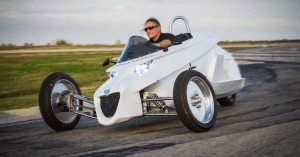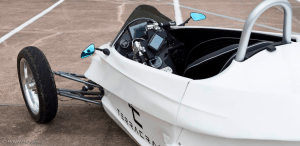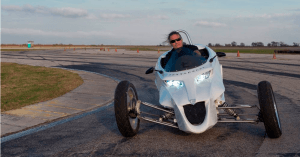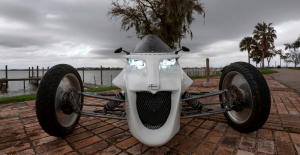
By Loz Blain,
Tilting three-wheelers are becoming more common, but there’s nothing out there like this. Terracraft’s SuperTrike gives you a pair of handlebars to control steering, but the tilt angle is chosen by an intelligent CoPilot computer system that keeps the cabin perfectly level over all sorts of undulations that would tilt a regular car around, and leans the trike into corners for a more aggressive and less nausea-inducing cornering experience. Now that the tilt/steering system is tested and proven, Terracraft is announcing it’s ready to accept orders. Gizmag spoke with Terracraft’s James “Wes” Abbott.
Terracraft’s tilting three-wheeler SuperTrike is still one of the most unique propositions we’ve encountered. Like many high performance three wheelers, it uses two wheels at the front, where they can maximize stability during hard cornering. But unlike just about anything else out there, the steering and tilting are managed by two entirely separate systems.
In the three years since we last spoke to Terracraft’s James ‘Wes’ Abbott, the Texas-based team has nailed down its steering and tilt systems and built a working vehicle that’s now on the street and turning a lot of heads.
Steering is simple enough; the Terracraft uses an ultra-narrow pair of clip-on handlebars, complete with motorcycle-style brake and clutch levers.

The tilt system is more interesting. In ordinary operation, tilt is controlled by an automated “CoPilot” system, a million lines of code that uses readings from a bunch of accelerometers, gyroscopes, wheel speed sensors and other position sensors to calculate and actuate the correct lean angle, some 1,000 times every second.
Without any input from the rider or passenger, the Terracraft will lean into a corner as you go around it. Motorcyclists will understand how this feels. Instead of your weight being pushed to the outside of the corner like it would be in a car, when you’re leaned over that weight pushes downward instead. It’s a secure feeling that can help prevent motion sickness when you’re going through the curves.
As you begin to corner, and the vehicle’s weight begins to shift sideways, CoPilot tilts the Terracraft to the perfect angle. Likewise, moving over uneven and undulating terrain, the software keeps the cabin perfectly upright where other trikes and regular cars would be tilting all over the place.
“It’s awesome,” Wes tells us, “It’s hard to explain the feeling. It’s like it’s alive, like you have an organic being controlling your front suspension. We have some pretty bad roads where our lab is, in the little back streets. Every crossroad is like a little jump. When you’re driving across that, the Terracraft is staying completely level the whole time, but you see the suspension rolling up and down, from left to right and you’re staying completely stable. You can look at the front suspension and see the CoPilot working at 1,000 Hertz, eliminating all the load your bottom would feel in a normal car.
“My wife won’t ride on my bike, but she loves the Terracraft. Every lady I’ve had in the Terracraft has just fallen in love with it. Their first reaction is ‘wow, it’s so smooth.’ It’s really cool, you don’t have to lean, it leans for you. A lot of them are used to being on the back of a bike and the rider saying “hey, lean with me.” It gives the rider and the passenger a level of security being in a cockpit with a full rollcage. There’s a seatbelt as well – it’s not required, it’s optional. We do fall into a motorcycle classification.”

The maximum lean angle is currently a modest 30 degrees, but Wes is looking at extending that figure. “We’re in some discussions with some key people about taking that up as high as 45. Around town, we’re not really exceeding 20 degrees unless we’re on the track or we’re breaking the law.
“Our center of gravity is pretty low and we have a 6-foot track, so even with no lean I can pull off some high speed maneuvers. You add that 30 degrees in there, if you go on a track [and corner at a level where more than 30 degrees might be needed], you’re still carving those curves.”
For those that want to take manual control of the tilt system, the Terracraft has a pair of buttons and a set of paddles on the handlebars. You can also turn on a system that reads the way your weight is shifting in your seat to determine what you want to do – the famous butt-sensor system. These can override the CoPilot’s control temporarily, or for more advanced control you can switch CoPilot automation off altogether.
“Most people just get in and drive with Terracraft CoPilot – the interactive options are for those of us that like to have extra control for extreme, fun or advanced maneuvers,” Wes tells us. “It’s a blast, just for showing off, or hotdoggin’, whatever you like to call it. You can take it and lean it right over at a stoplight in manual mode, and just pop that clutch and rip it… I’ll tell you what, you’re leaned in, so it doesn’t fishtail. With those two tires up front, it goes where you’re pointing it. You can countersteer it and break it loose, and just still have full confidence as it slides into alignment. Since you’re already leaning in, it doesn’t whip, it just locks up and launches. I find myself doing it all the time, just having fun.
“On a bike, if you drift, you risk getting bucked over the highside. You better be good. On this thing, boy, you can whip it round the corner and cut it loose whenever you want, and look like a pro. You don’t really have to develop a whole lot of skill, it makes you look more skilled than you actually are.”

Now that the steering and CoPilot software are mature and road tested, Terracraft is ready to start accepting orders. But the company is very wary of going the startup route and bringing large amounts of capital on board.
“We’re sticking with a low volume, custom, bespoke business model,” says Wes, “it’s a bootstrapping business model, catering toward the motorsport side and the high-end exotic supertrike market.
“[In a typical modern startup] you raise a ton of money and pay everyone a ton of money. We didn’t wanna chase that route and accumulate a lot of debt. We decided we wanted to do it organically, with a core team of people – a TerraTribe – that are passionate about pushing the state of the art.
“That was the criteria: we put together a team that wasn’t coming in needing a salary. All our team members are 100 percent service for equity, and/or they’ve bought their way in. They’re investors and contributing partners, they’re not dependent on the company for a primary income.”
As such, Wes says Terracraft is prepared to build maybe a dozen vehicles in the first 12 months. Prices will start around US$60,000, and scale upwards depending on what engine a customer wants (the prototype uses a 1500cc Honda Goldwing engine), and what level of componentry the buyer’s use case demands.
We like the look of the Terracraft. While it’s too wide to replace the motorcycle as a super-quick between-the-lanes commuting option, it should compete well against other three wheelers.
Compared to a Can-Am Spyder, it gives both rider and passenger a much higher degree of safety with the integrated roll cage. Compared to the Polaris Slingshot, it’s narrower with its tandem seating configuration, and its ability to lean should help make it more capable in the corners. At the very least, the driver and passenger won’t feel themselves being thrown toward the outside of the corner nearly as much as they do in a car.
And the CoPilot’s ability to smooth out road camber changes that even cars can’t manage will make it a unique and fascinating experience to drive. We’re looking forward to taking one for a spin, and keep an eye out for this happy face coming at you on the road!

